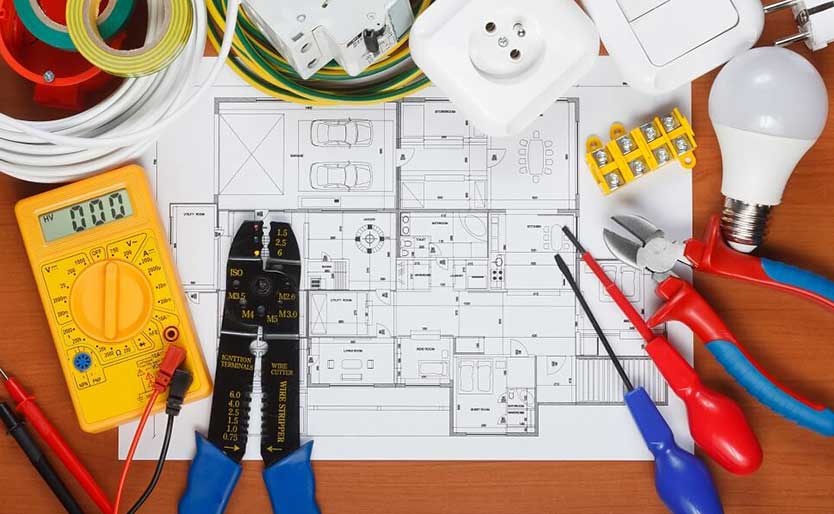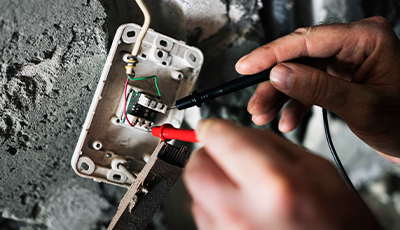Typical Electric Issues Every Home Owner Must Understand about
Home owners often experience numerous electrical issues that can affect safety and security and functionality. Issues like flickering lights and tripped breaker are much more common than many understand. These situations can show deeper electrical problems that warrant attention. Recognizing the indications and risks connected with out-of-date wiring and dead outlets is crucial. What measures can be taken to stop these issues? Exploring these usual electrical problems might disclose important insights for preserving a secure home environment.

Flickering Lights: Reasons and Solutions
Why do some property owners experience flickering lights? Flickering lights can be an usual aggravation, commonly suggesting underlying electric concerns. One main cause is loose or malfunctioning links within lighting fixtures or circuitry, which can lead to intermittent power supply. Additionally, utilizing high-wattage home appliances on the very same circuit may cause voltage fluctuations, leading to lowering or flickering. Another possible issue is an overloaded circuit, where a lot of devices draw power concurrently, straining the electrical system. Outdated or degraded circuitry can contribute to inconsistent electric circulation. In many cases, flickering lights may signal an issue with the home's electrical panel or service line. House owners need to resolve flickering lights quickly to prevent possible dangers. Solutions may include tightening up links, rearranging appliance tons, or getting in touch with a qualified electrical expert for a detailed analysis. Recognizing the origin can help ensure a risk-free and steady electric system in the home.
Tripped Circuit Breakers: What You Required to Know
Have house owners ever questioned what triggers their circuit breakers to journey unexpectedly? This usual problem typically occurs from an overload of electrical circuits, where also many gadgets draw power simultaneously. In such situations, the breaker serves as a safety system, disrupting the circulation of electricity to avoid overheating and potential hazards. Another constant reason is a brief circuit, which occurs when a real-time cable calls a neutral cable, producing a surge of electrical energy that journeys the breaker. Ground mistakes can additionally bring about stumbled breakers; these take place when a real-time wire touches the ground or a grounded surface, posing severe safety dangers. Home owners need to routinely evaluate their use of high-wattage devices to stay clear of straining circuits. Additionally, understanding the function of circuit breakers can assist them respond appropriately throughout a trip, guaranteeing their home stays properly maintained and safe.
Outdated Electrical Wiring: Indicators and Dangers
Outdated circuitry can posture considerable risks to property owners, frequently going undetected up until issues emerge. Homes developed before the 1980s may still have light weight aluminum electrical wiring or knob-and-tube systems, which are no more considered secure. Indications of outdated circuitry include flickering lights, often stumbled breaker, or melting smells near outlets. These signs might recommend that the electrical system is overloaded or deteriorating.Additionally, homeowners could see scorch marks around switches or outlets, which can show getting too hot. The danger of electric fires markedly enhances with out-of-date wiring, as these systems were not made to handle modern electrical tons. Home owners are encouraged to have their circuitry examined routinely, particularly when renovating or including brand-new home appliances. By acknowledging these signs early, they can prevent hazardous circumstances and keep a much safer living environment. Upgrading to present electric criteria is an aggressive action in maintaining home security and efficiency.
Often Blown Fuses: Repairing Tips
Constant blown fuses can suggest underlying electrical concerns that might come from out-of-date wiring or overloaded circuits. House owners experiencing this problem ought to first determine the appliances attached to the affected circuit. It is recommended to avoid utilizing multiple high-wattage tools concurrently, as this can lead to circuit overload. If the trouble lingers, examining the fuse box for signs of wear or damage is important; a damaged fuse box might need replacement.Additionally, looking for loose links within the circuit can assist avoid future events. Home owners should additionally verify that the merges being made use of are of the appropriate amperage, as making use of an inaccurate fuse can intensify the problem. Getting in touch with a licensed electrical expert is recommended to examine the electric system additionally if these troubleshooting tips do not resolve the concern. Dealing with these worries quickly can help mitigate threats and assure the safety and security of the home's electric framework.
Dead Outlets: Common Causes and Fixes
When a property owner runs More Help into a dead electrical outlet, it can often provide frustration and confusion. Several usual causes might result in this issue. One regular offender is a stumbled breaker, which can be easily reset. Property owners ought to check their electrical panel to examine if any kind of breakers are in the off setting. Another possibility is a defective outlet itself, which may require substitute. In addition, loosened electrical wiring connections within the electrical outlet can interrupt power circulation, making assessment essential.Sometimes, the problem may stem from an overloaded circuit, especially when several tools are connected. In such cases, redistributing the electric tons can settle the problem. Home owners must likewise think about the age of their electrical wiring; older systems might call for updates to satisfy contemporary electric demands. If these steps do not rectify the scenario, speaking with a certified electrical expert is recommended to assure safety and security and appropriate medical diagnosis.
Electrical Shocks: When to Be Worried
How can home owners determine whether an electric shock warrants concern? Property owners should first analyze the seriousness and context of the shock. A light static shock, frequently felt when touching steel things, is typically harmless and typical. Nevertheless, if the shock occurs while communicating with a plugged-in home appliance or outlet, it might show a more major issue.The place and frequency of the shocks are necessary. Repetitive shocks from the exact same source, specifically in damp locations like washrooms or kitchens, could signify faulty electrical wiring or insufficient grounding. House owners need to additionally take into consideration the experience of the shock; a shock that triggers discomfort or muscle mass contractions is more alarming than a plain tingle.If there's any type of uncertainty, it is suggested to seek advice from a qualified electrical contractor. Neglecting possible electrical threats can cause significant security risks, including fire or serious injury.
Overloaded Circuits: Avoidance and Security Actions
Overloaded circuits pose substantial risks in property settings, often causing electrical fires or tools damages (ASP Level 2 Electrician). Property owners must acknowledge the indicators of an overloaded circuit, such as frequently stumbled breakers or lowering lights. Carrying out preventative safety and security techniques can assist reduce these hazards and guarantee a much safer living environment
Acknowledging Overloaded Circuits
What indicators suggest his response that a circuit may be overloaded? Property owners ought to be vigilant for numerous key indications. Often stumbled circuit breakers or blown fuses suggest too much load on the circuit. Dimming or flickering lights, especially when various other home appliances remain in use, can symbolize an inadequate power supply. In addition, outlets or switches that really feel cozy to the touch might suggest overheating, a prospective fire threat. Uncommon buzzing noises from electrical outlets additionally require attention, as they can signify electrical problems. If appliances run inefficiently or fall short to start, it may be an indication of an overloaded circuit. Identifying these indicators early can assist stop severe electrical issues and advertise a more secure home environment.
Preventive Safety Practices
To maintain a reliable and safe electric system, home owners should implement precautionary safety and security practices that attend to prospective circuit overloads. One efficient action is to stay clear of connecting too many devices to a solitary electrical outlet, as this can go beyond the circuit's ability. Utilizing power strips with integrated breaker can help disperse power securely. Homeowners should additionally frequently evaluate cords and devices for damages and replace any defective equipment quickly. It is essential to guarantee that breaker are operating properly and to be familiar with the total power level being utilized in each circuit. Furthermore, speaking with an accredited electrical contractor for routine examinations can identify possible issues prior to they intensify, guaranteeing a more secure living environment and lengthening the lifespan of electrical systems.
Frequently Asked Inquiries
How Often Should I Have My Electrical System Inspected?
Routine assessments of electrical systems are suggested every three to 5 years. Property owners must consider a lot more frequent checks if they experience problems, undertake improvements, or reside in older residential properties to guarantee security and conformity.
Can I Deal With Electrical Issues Myself or Hire an Expert?

What Are the Indications of an Electrical Fire Threat?
Signs of an electrical fire risk consist of frequently tripped breaker, flickering lights, melting odors, discolored outlets, or cozy, buzzing wires. House owners must remain attentive and look for professional help if any one of these signs exist.
Just how Do I Know if My Home Needs an Electrical Upgrade?
To determine if a home requires an electric upgrade, indications include regular breaker trips, obsolete circuitry, insufficient electrical outlets, flickering lights, and the presence of older electric panels, indicating potential safety and security hazards and inefficiency.
Exist Certain Safety Tips for DIY Electrical Job?
When thinking about DIY electrical work, one should always shut off power, use shielded devices, validate circuit functionality, comply with regional codes, and get in touch with experts for complicated jobs to ensure safety and prevent mishaps. An additional prospective problem is an overloaded circuit, where also lots of devices attract power concurrently, stressing the electric system. The risk of electric fires significantly increases with out-of-date electrical wiring, as these systems were not designed to deal with modern electric loads. Constant blown merges can suggest underlying electric problems that might stem from outdated circuitry or overloaded circuits. To keep a efficient and risk-free electrical system, homeowners need to execute preventive safety techniques that deal with possible circuit overloads. ASP Level 2 Electrician. Indications of an electrical fire threat include regularly tripped circuit breakers, flickering This Site lights, melting smells, blemished electrical outlets, or warm, humming cords
Comments on “Recommended gear every Accredited Service Provider Level 2 Electrician uses for electrical safety”